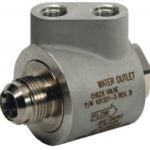Source: Combined Cycle Journal, Third Quarter 2009
Site
Progress Energy, Carolina’s Richmond County Energy Facility
Personnel Quoted: David Saad, O&R (operations and results) superintendent
Case Highlights
- Transfer reliability is in the upper 80s (percent) after installation
- Installations typically took one day per engine
- The first engine was equipped with the valves in 2006
Background
The station has five simple-cycle 7FAs and one 2 × 1 7FA-powered combined cycle. All engines are equipped for dual-fuel firing and have DLN2.6 combustion systems. When the 2 × 1 Siemens 501F-powered combined cycle is completed, the station will have a summer rating of about 1900 MW.
The peakers each start 100 to 200 times annually and run between about 1000 and 1500 hours. The combined-cycle is a mid-range unit. Unit run time on distillate ranges from about six to 25 hours annually—virtually all of that to keep the liquid-fuel systems exercised.
7FA Engine Performance Before Converting System Hardware to Improve Reliability
Saad recalled that fuel-transfer reliability was in the low 60s (percent) with standard check valves and the reason why the plant switched to JASC.
7FA Engine Performance After Converting System Hardware
Today transfer reliability is in the upper 80s (percent). The O&R Superintendent cautioned that not all fuel-transfer failures are related to the check valves.
Conversion Process

The O&R superintendent classified the process as “not difficult.”
Plant personnel prefabricated all the lines after the trial installation, which took about two days per unit. Staff also did the installation— typically a day for each engine. Early on, Saad added, they operated the check-valve cooling circuit with a delta P that was too high: 50 psi. Overcooling allowed unwanted wax to come out of solution. Reducing the differential pressure to 12 psi eliminated the issue.
To assure that the plant maintains fuel-transfer reliability at a high level, and to avoid any failed fuel transfers being attributed to check valve problems, the check valves are removed from each combustor and hot-gas-path inspection and returned to JASC for servicing.
Installation
All engines have JASC water-cooled liquid-fuel check valves—14 per GT (one per combustor). The first engine was equipped with the valves in 2006.
Water for valve cooling comes from the closed cooling-water system, which recirculates a mixture of water and glycol. The fin-fan cooler for the peakers supplies water at about 130F in summer; and for the combined cycle at about 150F. Such hot water for cooling is not problematic because the goal is to keep the check valves under 250F.
According to the O&R superintendent, the few check-valve problems experienced were cooling-water related.
